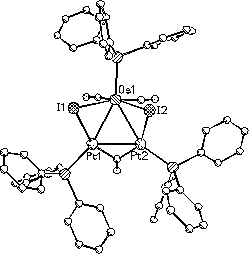
CRYSTAL STRUCTURE OF NOVEL MIXED-METAL CLUSTER COMPLEX OsPt2(-I)2(-CO)(PPh3)3(CO)20.5C6H14. V.P.Kirin, A.V.Virovets, V.I.Alekseev, N.V.Podberezskaya, V.A.Maksakov Institute of Inorganic Chemistry SB RAS, Novosibirsk, Russia
The title compound with unexpected asymmetry in the cluster core was prepared by the reaction (benzene, 80oC, 1.5h):
Os2(-I)2(CO)6 + Pt(PPh3)2(PhC2Ph)
OsPt2(-I)2(-CO)(PPh3)3(CO)2 + Os2(-I)2(CO)6-n(PPh3)n (n=1,2).
The first product was crystallized from Et2O/n-C6H14 3:1 mixture:

Crystal data: monoclinic, a=21.073(4), b=15.533(3), c=18.753(3) Å, ß=109.86(2)o, V=5773(2) Å3, P21/c, Z=4, Dx=2.011 gcm-3, CAD4, MoK, RF=0.0567 for 3617 Fhkl>4(F). Presence of two Pt atoms in this cluster corresponds with the 31P and 195Pt NMR data. Os and Pt atoms were distinguished taking into account their ligand environment: 2CO+2I+PPh3 for Os, I+PPh3+CO-bridge for both Pt atoms.
Some bond distances: Os-Pt 2.796(2), 2.852(2), Pt-Pt 2.685(2), Os-I 2.769(2), 2.787(2), Pt-I 2.694(2), 2.745(2), Os-P 2.380(8), Pt-P 2.248(8), 2.250(8) Å. The most interesting feature of the complex is that the -I ligands are coordinated asymmetrically (angles between OsPt2 and OsPtI planes are 42.0o and 84.5o) which affects on the Os-Pt bond lengths. The possible reason for this is the repulsion between bulky PPh3 and I ligands.